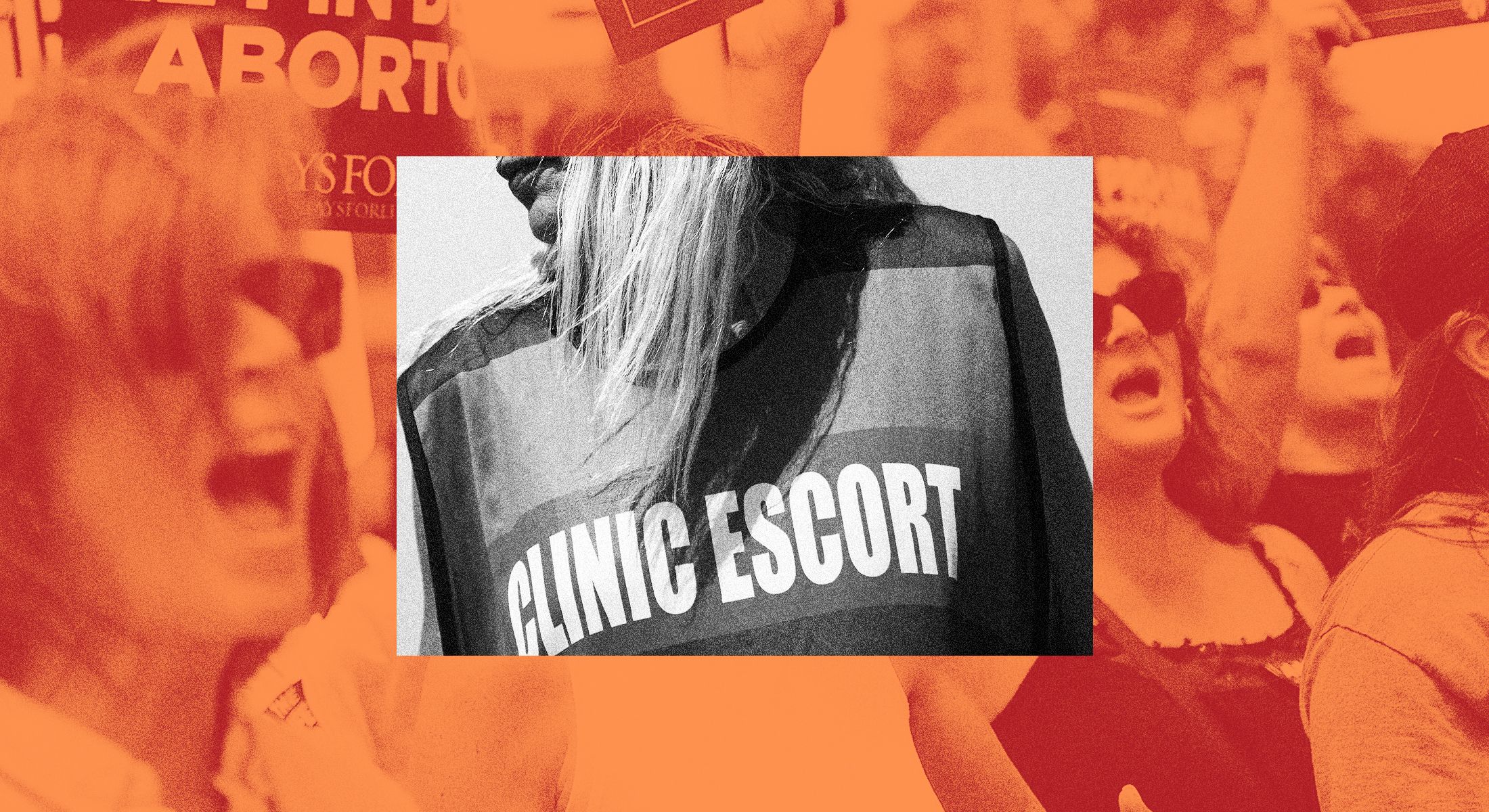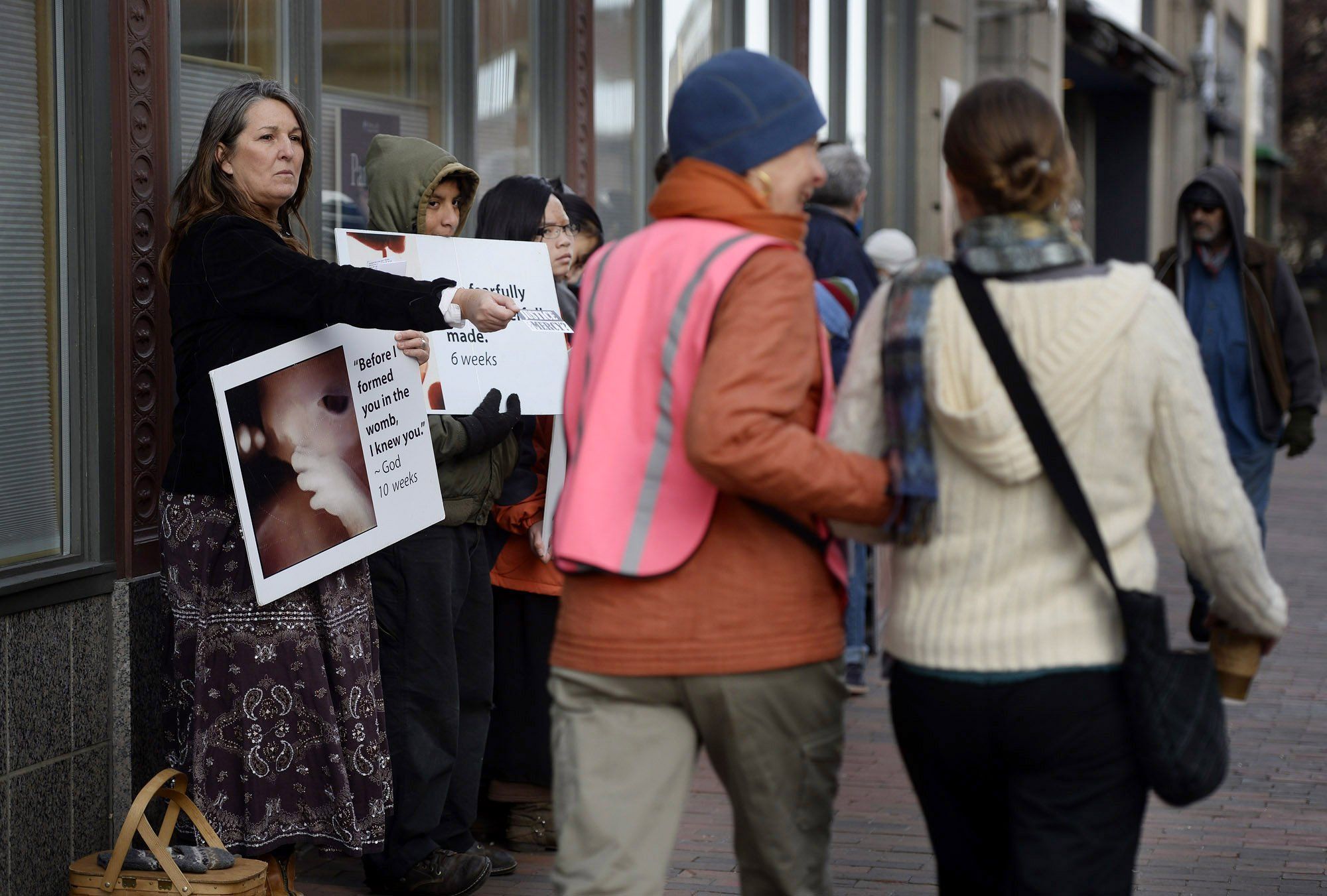Standing Between Care and Violence
Abortion-clinic escorts and defenders serve as human shields protecting patients from angry, aggressive protestors. Now, with emboldened extremists and the COVID crisis, they face more danger than ever before.


Shelley, an abortion-clinic defender at Clinics for Abortion and Reproductive Excellence (CARE) in Bellevue, Nebraska, had a bad feeling on the morning of September 25, 2020. One of those gut bad feelings. It had been a volatile summer. Warmer months typically bring more anti-abortion-rights protesters to clinics, and the groups had been even larger than usual in 2020, likely due to high unemployment rates. By September, the crowds had begun to thin back down to the clinic’s 12 to 14 “regulars.” That morning, one of the regulars was camped out in his usual spot at the base of the clinic’s driveway.
For months, the man had spent Saturdays standing there, wearing a vest made to look identical to the ones that CARE clinic volunteers wear (rainbow colored). Sometimes, he’d bring an assistant dressed in scrubs. “He would say, ‘I’m Dr. So-and-so and I work here. What time is your appointment?’” recalls Shelley. After pretending to check patients in to what they presumed was CARE, he’d instead direct them to Essential Pregnancy Services (EPS), a crisis pregnancy center (CPC) located across the street. CPCs, intended to dissuade people from having abortions, are known to use deceptive tactics, including lying to patients about how far along they are in their pregnancies and making false claims about risks associated with abortion.

A clinic escort directs a woman seeking care. Protestors line the walk.
Shelley, who is using her first name only to protect her privacy and safety (like all of the women who agreed to speak for this article), brought concerns about the man’s deceptive behavior to local law enforcement multiple times. Police told her the man wasn’t technically lying—he has a PhD—and that even if he was impersonating a medical doctor, it would be illegal only if he was profiting from it. But he is not an employee of EPS, and the services there are free anyway. “It made me physically ill. I [even] watched him climb into the cars of patients, and I just couldn’t do it anymore,” Shelley says. So, with permission from CARE, she took up a post in the driveway to alert patients to the deceit. In response, more protesters—and more defenders—gathered in the area, creating a distraction that allowed patients to enter CARE mostly unnoticed through a quieter back driveway.
After Shelley began taking an active role in redirecting patients, the man became physically aggressive with her, she says, frequently trying to block Shelley from talking to patients. Then, on September 25, as the two took up their usual posts in the driveway, the man directed his wife to stand in a specific spot and film his interaction with Shelley. “I knew something was going on. I started to get really scared,” she recalls. Video that Shelley took on her own phone shows the man pushing a blank white poster board toward her. One of Shelley’s arms is outstretched, trying to keep him away. A car can be heard pulling in to the clinic’s driveway. Shelley shouts out, “Keep driving, keep driving!” and suddenly, the man hits her with the poster board. The repeated thud of the poster board hitting Shelley can be heard in the video.
“Call the police. She just wrecked my sign,” the man says, while Shelley is still screaming. “That cost a hundred dollars,” he says later, pointing to the broken poster board. “You’re in big trouble. You’re going to jail,” he continues, according to the footage. Shelley now believes that the attack was intended to set her up for “destroying” his property. At the time, all she felt was fear.
“He took this giant poster board and basically broke it over my face and started to push me back. It happened so fast, and it was so scary that I was in shock. ...I really thought he was going to kill me.”
If you’ve been to an abortion clinic or driven past one, you’ve probably seen clinic escorts, defenders, or both in their signature brightly colored vests. These are two distinct roles that volunteers train for. (Training varies by clinic and location, but it usually involves a day or a weekend’s worth of education and mock situation practice with a more senior escort or defender.) The most important difference is that clinic defenders engage with protesters while escorts do not. Defenders distract or drown out anti-abortion-rights demonstrators, aiming to deflect harassment from patients entering the clinic. They may talk back to protesters or make noise, playing music, ringing bells, or shouting into bullhorns (something Shelley did often). Escorts, on the other hand, usually follow strict policies of non-engagement. They speak only to patients, providing them with comfort and helping them navigate the chaotic environment that exists outside many clinics. Escorts often use umbrellas to shield patients and their license plates from prying eyes and cameras. In states where abortion is more accessible, clinic escort collectives tend to have long waiting lists of interested volunteers. Recruiting can be more challenging in restrictive states, though many volunteer groups saw their numbers increase in the aftermath of the 2016 presidential election.
Get exclusive access to fashion and beauty trends, hot-off-the-press celebrity news, and more.
While they have different duties, both escorts and defenders serve as a buffer between protesters and patients, standing on the front lines in an increasingly hostile climate of anti-abortion picketing and violence. Even before she was assaulted, Shelley wore a bulletproof vest to her shifts at the clinic.
Since 1993, at least 11 people have been killed in anti-abortion attacks by extremists, and acts of violence have been on the rise for several years. Many who work and volunteer at abortion clinics say that anti-abortion-rights demonstrators were emboldened by the election of former president Donald Trump, and statistics support their personal experiences: According to the National Abortion Federation, a professional association of abortion providers, violent incidents at abortion clinics more than doubled in the span of a year, from 521 incidents in 2016 to 1,081 in 2017. In 2019, the most recent year for which complete statistics are available, there were 1,724 acts of violence at abortion clinics. Protests continue to increase in size and frequency: There were more than 123,000 incidents of picketing in 2019, compared with just over 99,000 in 2018.
I really thought he was going to kill me.
Despite the new administration, the violence hasn’t ceased. In fact, some clinic escorts and defenders feel it has escalated even further since Trump lost reelection. In January, a shotgun was fired at the doors of a Knoxville, Tennessee, Planned Parenthood; the FBI is now assisting in that investigation. Later that month, a Charlotte, North Carolina, clinic received a bomb threat credible enough that patients had to be evacuated. In nearby Raleigh—where it is illegal to have guns at a protest—an anti-abortion-rights protester accidentally shot himself in the leg at a demonstration in March. The police did not check other protesters for firearms.
There have also been several clinic blockades and invasions in the first few months of this year. These tactics—in which protestors block entrances and exits to clinics, or even enter a clinic to accost patients—were common in the 1980s and ’90s, when extremism in anti-abortion-rights activism was the norm. Attempted and successful murders, bombings, and arsons targeting abortion providers were at an all-time high during that period. But in 1994, President Bill Clinton signed the Freedom of Access to Clinic Entrances (FACE) Act. The law introduced criminal and civil penalties for blocking the entrance to an abortion clinic or interfering with or intimidating patients and staff. Blockades and invasions thus declined. Clinic defense, a common practice in the volatile ’90s, receded as well.

A clinic escort wears a brightly colored vest to help identify themself to patients.
While the Department of Justice under Clinton was aggressive in pursuing FACE Act violations, criminal and civil enforcement of the law fell precipitously under President George W. Bush and never rebounded. Reproductive-health providers do have standing to bring civil suits under the FACE Act, but they rarely have the resources to do so. Fighting abortion restrictions is a higher priority.
Most abortion clinics around the country have escorts, the majority of whom are women and nonbinary people. Defenders are less common but increasing in number, in part as a response to the mounting violence. Some clinics need both. A Preferred Women’s Health Center (APWHC) in Charlotte, the target of the January bomb threat, for example, has escorts who speak only to patients and stay in the clinic’s parking lot. Defenders stand on the sidewalk, where they engage with protesters as far away from patients as possible. CARE uses a similar model. The dual approach is needed to help protect patients and clinics from the violence perpetuated by anti-abortion extremists. “[Anti-abortion protesting] is an industry. So many of them are making a living off of this, whereas most of our groups are unpaid grassroots volunteers,” says Heather, a board member of Charlotte for Choice, a volunteer reproductive-rights group that coordinates escorts and defenders at APWHC. “This is not your Catholic granny with her rosary quietly doing some Hail Marys.”
Shelley’s attacker certainly wasn’t quietly praying. The assault lasted less than a minute, but Shelley feared it would end in her death. Eventually, she managed to scramble onto the clinic’s privately owned property, where protesters generally know they aren’t allowed to follow. Another escort called the police. But patients still needed to get into the clinic, and Shelley’s assailant had returned to his spot in the driveway.
“I didn’t want to let him win, even though I was terrified and bleeding. Another car was pulling in, and I just went and did what I normally do. He didn’t hit me that time, but he sure came close,” she says.
When the police arrived a short time later, Shelley was worried they wouldn’t take her story seriously. But there was evidence: In addition to Shelley’s video, there was the video her attacker’s wife had taken, and the assault was captured on the clinic’s security cameras and witnessed by bystanders. “The police were really helpful, which is not always the case in these situations. They did a full investigation,” Shelley says.
After reviewing video that corroborated Shelley’s account, the police advised her to leave the clinic before they told her attacker that he would be charged with assault. “They were nervous about his reaction,” she says. At first, she wasn’t sure she wanted to press charges. Not only is litigation time-consuming, Shelley also worried that pressing charges could make her more of a target for people with anti-abortion views. But she has been buoyed by support from fellow escorts and defenders, whose numbers surged after her assault. The group has grown from just a few volunteers to a solid crew of about 12. “It has become a powerful community, and one in which I feel so safe,” Shelley says.
But abortion providers and those in the ecosystem that supports them seem to face a greater risk today than ever before. In addition to the recent increase in violence, the pandemic has added a new twist to the issue with escorts across the country reporting that anti-abortion-rights protesters have weaponized COVID. Protestors rarely wear masks, according to many escorts interviewed for this piece, and they intimidate patients and escorts alike by getting physically close to them. Some escorts say protesters have even coughed in their faces, purposefully. “They make fun of us for wearing masks,” says Heather. Christine, an escort at EMW Women’s Surgical Center in Louisville, Kentucky, says some protesters claim it is against their religious views to wear a mask. “They think it is not trusting in God,” she says. On at least one occasion, police were called to EMW due to large groups of maskless protesters, but Christine says they left without dispersing the crowd. The patients and volunteers continued to be at risk of contracting a deadly respiratory virus.
A growing number of anti-abortion-rights groups travel cross-country to target specific clinics—a practice they have maintained through the pandemic—causing the number of demonstrators to swell when they come into town. Sometimes, they surprise a usually quiet clinic that might have few volunteers. But they have favored targets. CARE is one of them because it is headed by LeRoy H. Carhart, one of very few physicians in the country who speak openly about providing abortions in the third trimester of pregnancy. Abortions later in pregnancy are rare but highly stigmatized, and Carhart has fielded countless death threats. His friend and colleague George Tiller, also known for providing later abortion care, was murdered by an anti-abortion extremist in 2009.

Escorts usually wait outside of a clinic to help direct patients from their cars to the right place.
Another popular target is EMW. Until 2020, when a Louisville Planned Parenthood started providing abortion services, EMW was Kentucky’s last abortion clinic. (Protesters often target the last remaining clinic in a given state or region.) EMW is located in a complex with other medical offices; the entrance is directly off of a public sidewalk, and demonstrators routinely block the doors with graphic signs, leaving little space for patients to pass through.
Escorts don’t necessarily feel comfortable calling the police when protesters get out of hand. Some escorts even suspect police are sympathetic to anti-abortion protesters. (In the U.S., 58 percent of women of reproductive age live in states that are considered hostile to abortion rights.) They also worry that a police presence at the clinic could intimidate patients or even lead to harm, especially toward women of color. In February, Christine says she saw a man outside the clinic with a gun on his hip. He was holding a sign for 40 Days for Life, an internationally coordinated anti-abortion campaign with Catholic roots. She didn’t think much of the gun at first because Kentucky is an open-carry state. “For every gun we see, there are probably 10 we don’t see,” she says. But then the man drove away in a police cruiser.
Christine says protesters’ rhetoric has become increasingly violent and inflected with more white-nationalist talking points since the 2016 election. Even protesters who may not personally engage in violence are willing to capitalize on the violent actions of others. In a recent incident, Christine says a woman she describes as unhoused—meaning without a fixed residence, otherwise known as homeless—assaulted a patient after being incited by protesters. Christine recognized the woman, having seen her around the clinic before, and noticed that on this day she was wearing a 40 Days for Life shirt.
This is not your Catholic granny with her rosary quietly doing some Hail Marys.
As one patient approached the clinic, the woman grabbed her and dragged her away. Protesters surrounded the patient, talking to her for around 10 minutes. When the patient tried to continue to the clinic, the woman grabbed her again. Eventually, an escort intervened (there are no clinic defenders at EMW) and helped pull the patient to safety. The police weren’t notified of the assault. “I’m not going to call the police on an unhoused person in crisis,” says Christine. She points out that patients, staff, and escorts are free to call the police if they want, but that filing a police report means making your name and address a matter of record, another deterrent.
At APWHC in Charlotte, the police are typically present on Saturdays because of the sheer size of the crowds, which far outnumber those elsewhere in the country. APWHC has two buildings: a clinic building and an administrative building. Next to its administrative building sits an empty lot owned by an LLC that allows an evangelical anti-abortion-rights group called Love Life to use the space. Every Saturday during its 40-week campaign (not to be confused with 40 Days for Life), Love Life erects what some clinic volunteers call “Christian Coachella.” Crowds of 200 or more people gather, mostly unmasked, near a large stage with booming, amplified sound.
There is a consistent protester presence in smaller numbers on weekdays, and Heather and a fellow board member at Charlotte for Choice, Shannon, say that blockages seem to be increasing since the 2016 election. Protesters routinely stop traffic, even intentionally jumping in front of cars. Heather says she’s been hit with signs and feels more concerns for her safety now than at any time since she started volunteering at the clinic in 2017. The protestors even hired an armed security guard who came to the outside of the clinic with a gun, an apparent intimidation technique. (Police removed the gun from his possession, but it was still unnerving.)

Escorts and defenders may use umbrellas to shield patients. The umbrella has somewhat become a symbol of their work.
The bomb threat was called in to APWHC on a Saturday, which meant that the crowds were present when some patients had to evacuate the building. Volunteers stepped in to shield them. “One good thing is a lot of our volunteers are cross-trained,” says Heather. On the day of the attack, there were only two escorts on shift. “Within probably two minutes, as the patients started coming out to be exposed, there were 15 escorts,” says Shannon. “Some of us have extra umbrellas, and they just immediately popped up all over. It was just a sea of umbrellas. It was scary, and it was horrible, and I hated it. But it also showed that escorts are really putting their bodies on the line to protect these patients.”
Although the violence at clinics rages on, Shelley, for one, finally got a small dose of justice. In March, Shelley’s attacker stood trial for assault in Nebraska county court. On April 27, a judge found him guilty of assault in the third degree. However, the judge also ruled that the incident was a “scuffle entered into by mutual consent.” Shelley says she’s been told, “That’s essentially the equivalent of getting into an argument in a bar and saying, ‘Let’s take this outside’ and then getting punched in the face.” Legally, it means her attacker would face a lesser sentence. The maximum penalty for his offense is six months in jail, a fine of $1,000, or both. There is no minimum, and the penalty is completely up to the judge’s discretion. On May 13, his sentencing was announced: Shelley’s attacker got probation with minimal supervision for 12 months and a fine of $50, plus court costs. He was also sentenced to 15 days in jail, but that will be waived as long as he serves his probation.
“It feels a lot like I’m being told that I was asking for it or that I consented to the assault simply because I was doing the volunteer work that I do every week,” Shelley says. “I don’t think I need to describe for most people what the implications are behind telling women that violence they endure is somehow their fault or was egged on by them.”
Despite the weak sentence and “mutual consent” decree that essentially equated standing on a sidewalk with hitting someone over the head, Shelley appreciates that the outcome of her case is monumental in its own way. “While it’s not entirely the ruling I hoped for, the fact that a man who is connected, wealthy, and aligned with political leaders in my state was convicted is a huge win, in my opinion. Abortion-clinic escorts rarely see justice for the violence they endure, and so for that I am extremely grateful.”
No matter the cost, Shelley refuses to quit protecting those trying to access care. “Clinic escorts are aware of the risks that they take on the sidewalk, but what we all have in common is that we understand that there should be no risk at all. Abortion is safe. Abortion is normal.”
Related Stories


Garnet Henderson is a Wyoming-born, New York-based freelance journalist reporting on health and abortion access. Her work has appeared in publications including Marie Claire, VICE, WIRED, Glamour, Scientific American, Elemental, the Guardian, and others. She is also the host and producer of ACCESS: A Podcast About Abortion.
